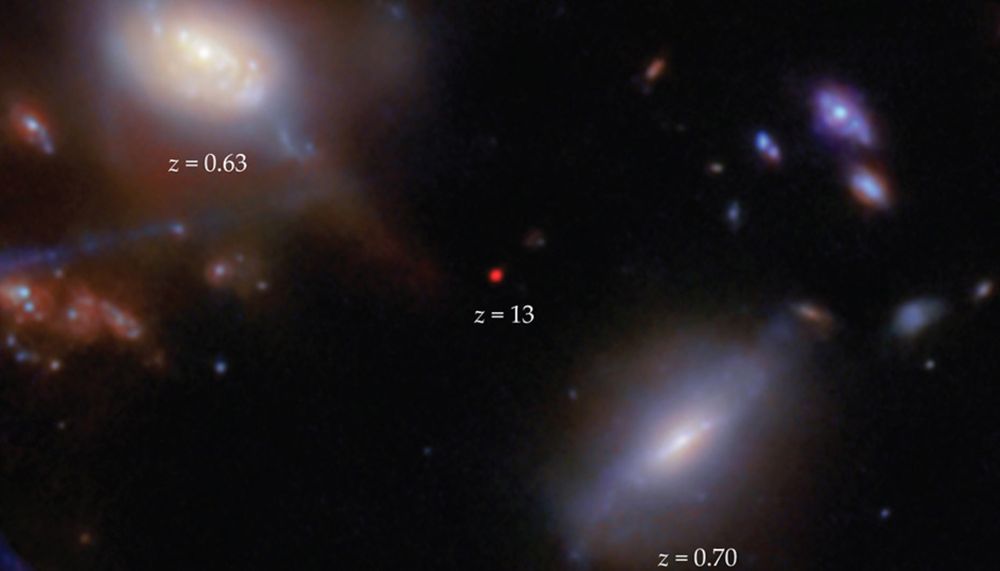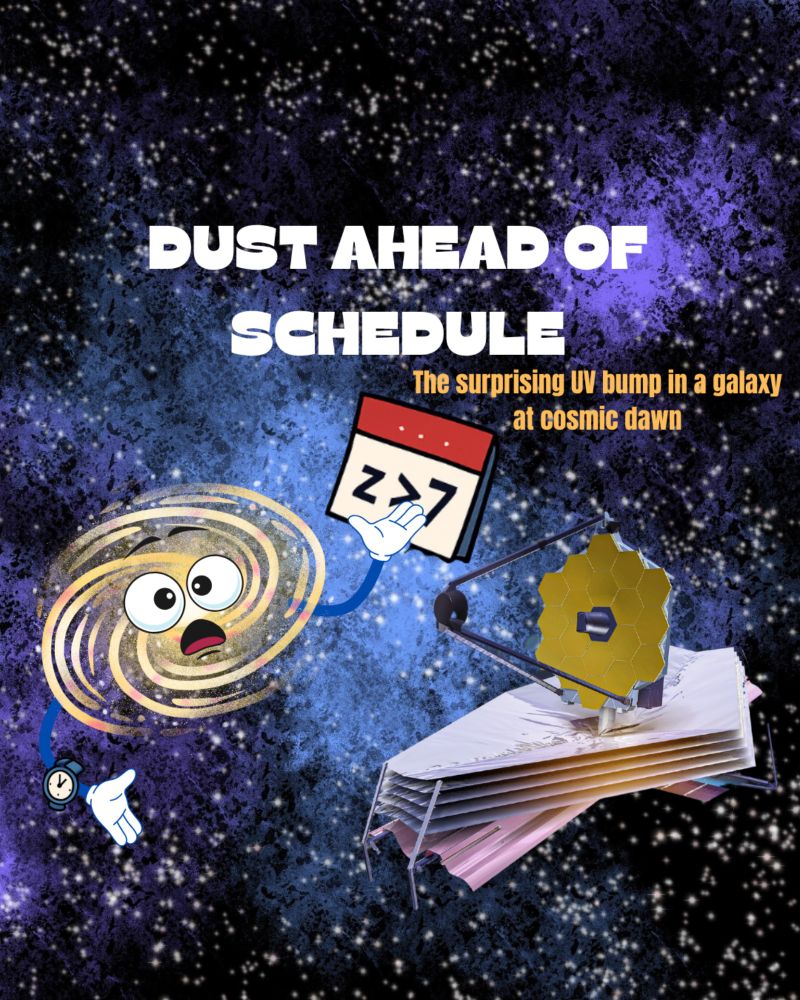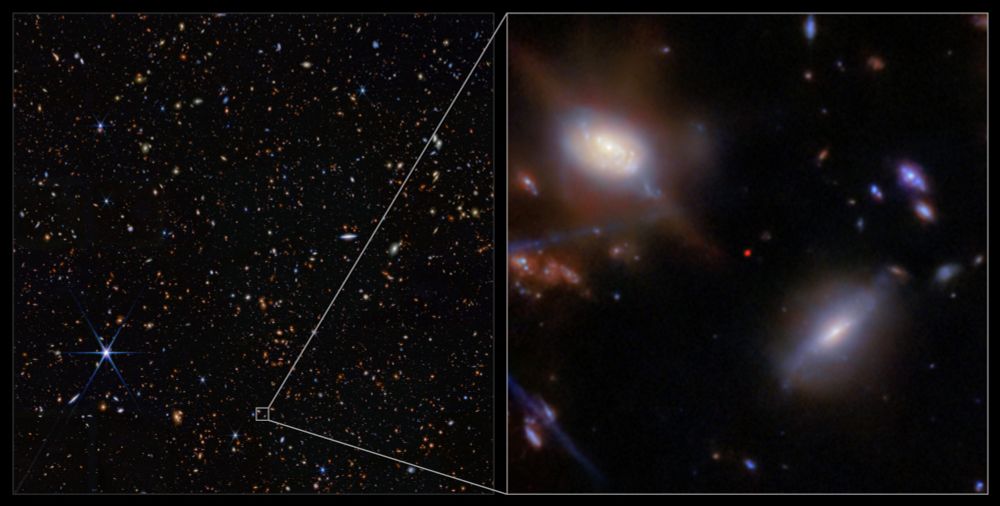Come to our conference in April next year! 🧭🌌🏰
👉 Submit your abstract here: docs.google.com/forms/d/e/1F...
13.08.2025 14:03 — 👍 3 🔁 0 💬 0 📌 0
Incredible outfit for no doubt an incredible PhD thesis! Congrats Dr Helton 🥳🍾
01.07.2025 07:39 — 👍 1 🔁 0 💬 0 📌 0

Currently watching the first light from
@vrubinobs.bsky.social’s 3200 megapixel camera 🤩
23.06.2025 16:02 — 👍 4 🔁 2 💬 0 📌 0


🧵 Today is paper day for me! Usually I don’t post about papers but I have a special soft spot for this one: the detection of the Gunn-Peterson trough in high-redshift *galaxies* !!
arxiv.org/abs/2504.02683
#astrosci #extragalactic #cosmology
04.04.2025 13:32 — 👍 23 🔁 4 💬 1 📌 1
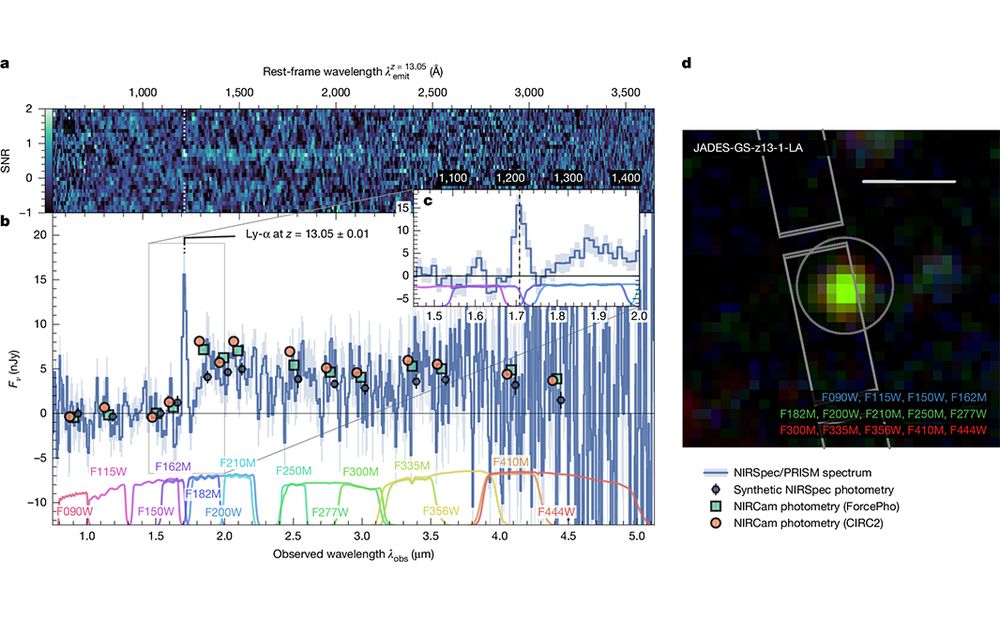
This is figure 1, which shows NIRCam and NIRSpec/PRISM observations of JADES-GS-z13-1-LA.
A paper in Nature reports observations from the JWST showing one of the earliest known galaxies caught in the act of reionization. The observations place the onset of cosmic reionization to at least 330 million years after the Big Bang. https://go.nature.com/4hLNK12 🧪 🔭
27.03.2025 16:21 — 👍 21 🔁 8 💬 2 📌 1
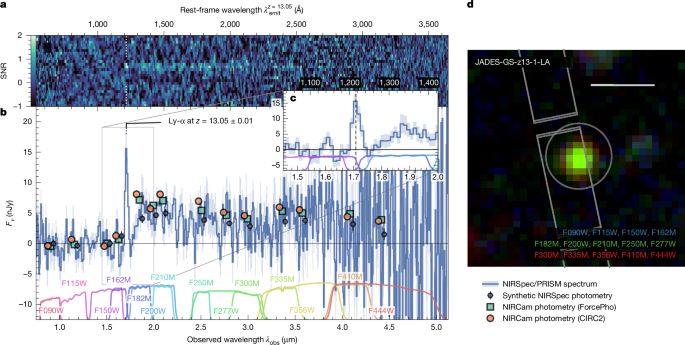
Witnessing the onset of reionization through Lyman-α emission at redshift 13 - Nature
Spectroscopy from the JWST Advanced Deep Extragalactic Survey of a galaxy at redshift 13 shows a singular, bright emission line identified as Lyman-α, suggesting the onset of reionization only 330 Myr...
Paper day! And it’s a big one 🥳
Today, a team of researchers led by @joriswitstok.bsky.social — A DAWN fellow @cosmicdawncenter.bsky.social and Post-doc in the PRIMORDIAL group — published a paper in @nature.com reporting the detection of Lyman-alpha emission from a galaxy at redshift 13 (!)
🧵👇
26.03.2025 19:11 — 👍 6 🔁 1 💬 1 📌 0
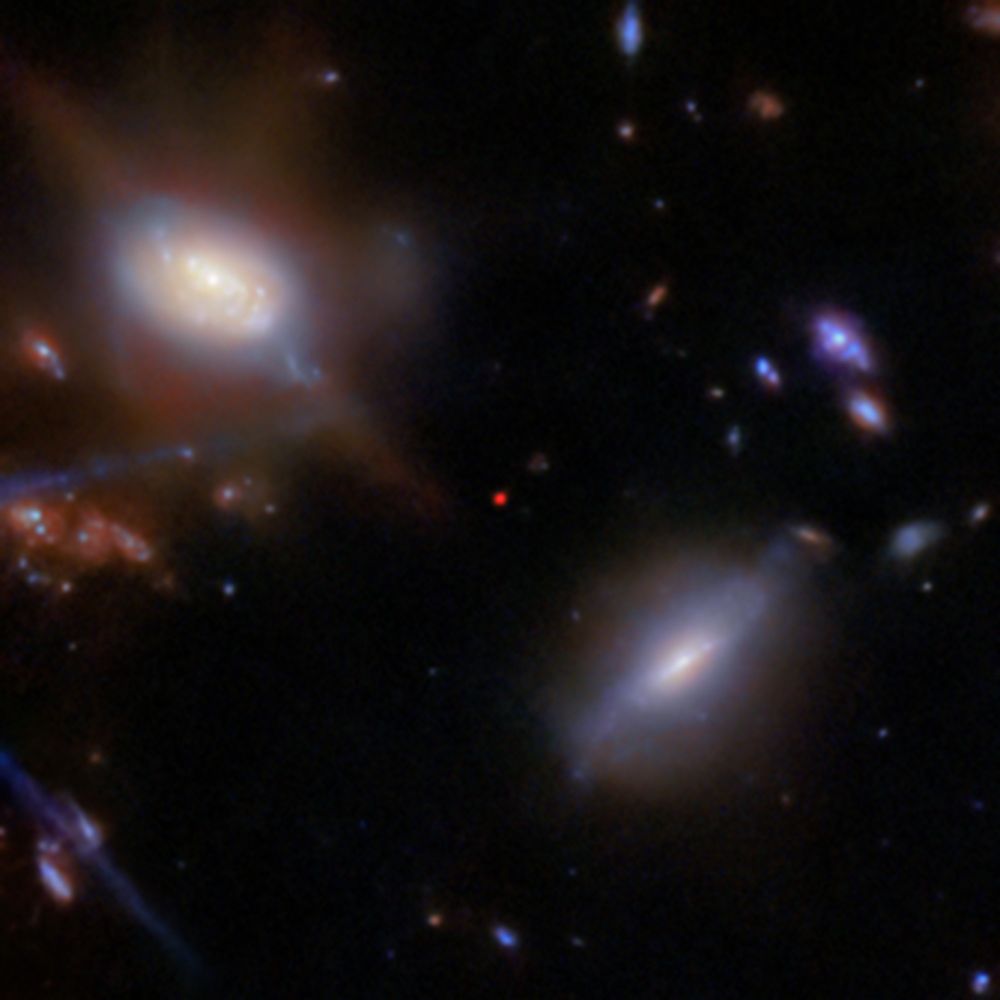
A small red dot is in the middle of the image. To its upper left is a face-on spiral galaxy, and to its lower right is an edge-on spiral galaxy. A handful of other small background galaxies are seen against the black background of space.
Using the unique infrared sensitivity of #NASAWebb, researchers can examine ancient galaxies to probe secrets of the early universe. Recently, a bright hydrogen emission from a galaxy in an unexpectedly early time in the universe’s history has been identified. (1/4) 🧵 🔭 🧪
27.03.2025 15:22 — 👍 97 🔁 10 💬 4 📌 0
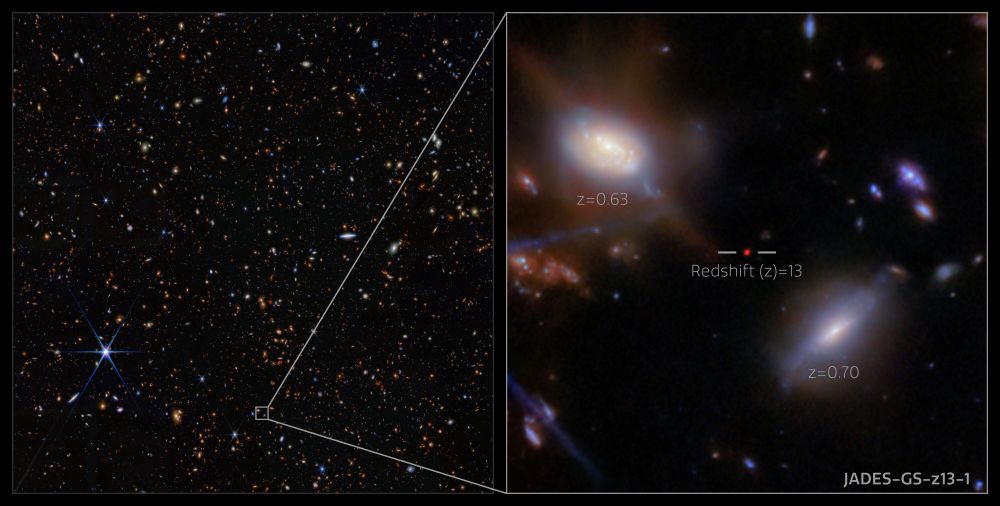
An area of deep space is covered by a scattering of galaxies in many shapes and in colours ranging from blue to whitish to orange, as well as a few nearby stars. A very small square is shown zoomed in, in a box to the left. In the centre a red dot, a faraway galaxy, is marked out by lines and labelled “Redshift (z)=13”, signifying its extreme distance. Two much larger galaxies are labelled “z=0.63” and “z=0.70”. The box is titled “JADES-GS-z13-1”.
Astronomers have identified powerful hydrogen emission in one of the most distant galaxies known — a probable sign that we are seeing some of the first hot stars from the dawn of the Universe ✨
All thanks to the NASA/ESA/CSA James #Webb Space Telescope.
Read more 👉 www.esa.int/Science_Expl...
🔭🧪☄️
26.03.2025 16:10 — 👍 276 🔁 53 💬 7 📌 5
I've been lucky to work on this amazing data together with Peter Jakobsen (also at @cosmicdawncenter.bsky.social), Roberto Maiolino, @renskerens.bsky.social, @aasaxena.bsky.social, and many others.
27.03.2025 15:41 — 👍 2 🔁 0 💬 1 📌 0
Special thanks goes to @kevinhainline.bsky.social, Brant Robertson, Ben Johnson, @sandrotacchella.bsky.social, and others, who orchestrated the initial search leading to the discovery of this galaxy.
27.03.2025 15:41 — 👍 1 🔁 0 💬 1 📌 0
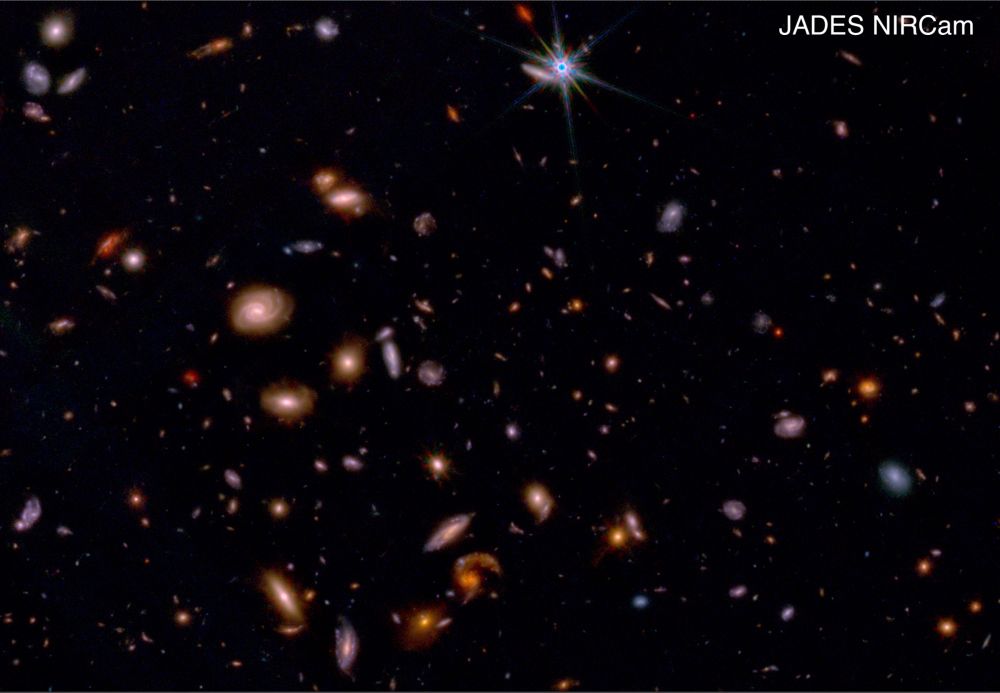
JADES
The JWST Advanced Deep Extragalactic Survey (JADES) is exploring the universe of high-redshift galaxies using the transformative opportunity of the James Webb Space Telescope.
Needless to say this was a huge team effort by the JADES collaboration, and would not have been possible without key contributions from a large number of international scientists.
JADES website (with interactive image viewer): jades-survey.github.io
27.03.2025 15:41 — 👍 0 🔁 0 💬 1 📌 0
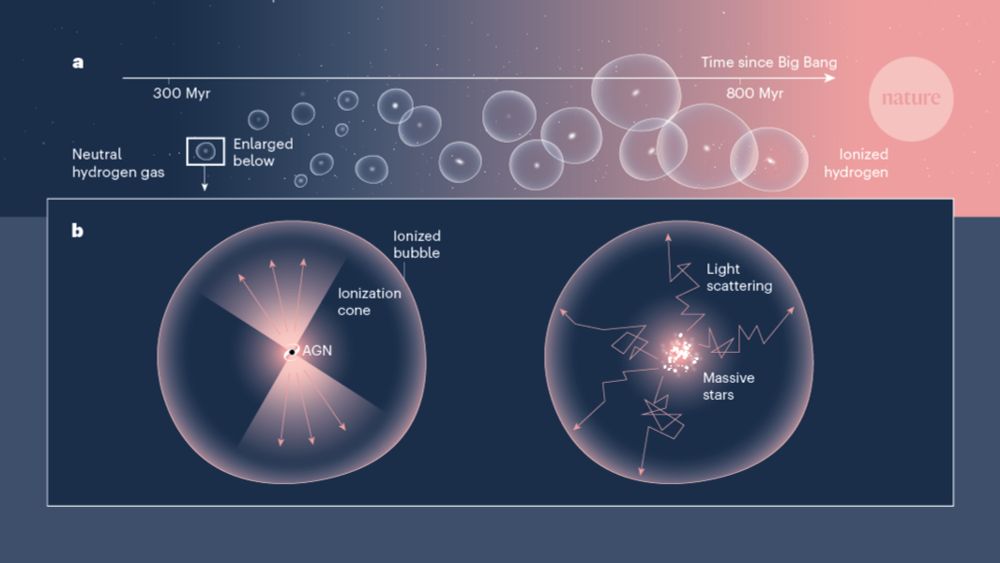
A lighthouse galaxy shines unexpectedly through the fog of the cosmic dawn
Ancient UV light illuminates how galaxies and black holes first formed.
This also implies the galaxy contains a remarkably powerful source of extreme ultraviolet radiation, either in the form of extraordinarily massive, hot stars or a supermassive black hole rapidly consuming nearby gas.
As illustrated beautifully in the News & Views article by Michele Trenti:
27.03.2025 15:41 — 👍 1 🔁 0 💬 1 📌 0
In JADES-GS-z13-1, JWST has confirmed one of the most distant galaxies known to date. But unlike any other similarly distant galaxy, it shows a very clear, telltale signature that can only be seen once the surrounding fog has fully lifted.
27.03.2025 15:41 — 👍 0 🔁 0 💬 1 📌 0
While the Universe right after the Big Bang was blisteringly hot, a rapid expansion and cooldown subsequently rendered it opaque to energetic ultraviolet light. This ‘fogginess’ was gradually cleared out when bright starlight from the first galaxies started a process known as cosmic reionisation.
27.03.2025 15:41 — 👍 0 🔁 0 💬 1 📌 0
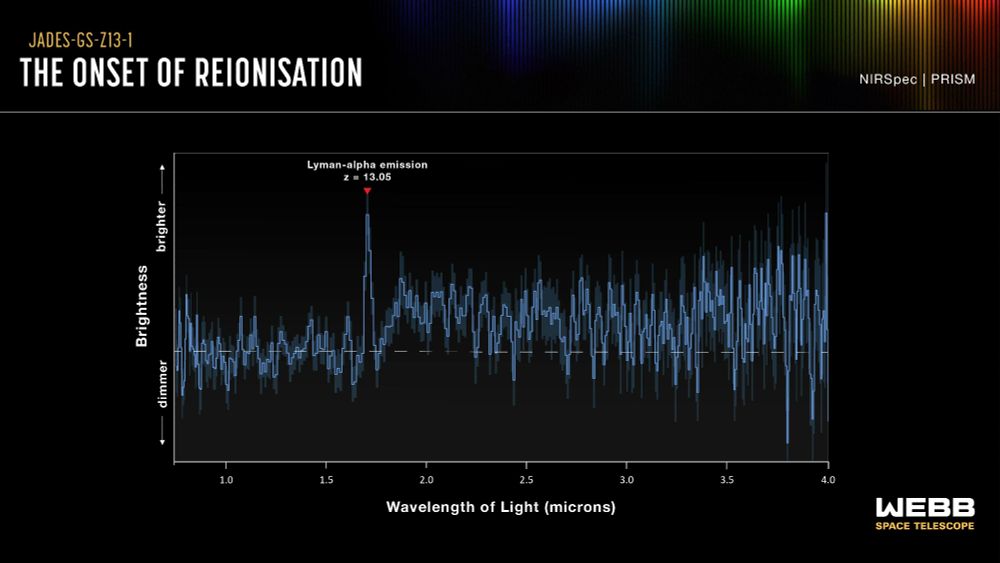
Using the James Webb Space Telescope (JWST), we identified bright hydrogen emission from a galaxy at an unexpectedly early time in cosmic history. But why is this result so surprising?
Image credits: ESA/Webb, NASA, CSA, STScI, J. Olmsted (STScI), S. Carniani (Scuola Normale Superiore), P. Jakobsen
27.03.2025 15:41 — 👍 0 🔁 0 💬 1 📌 0
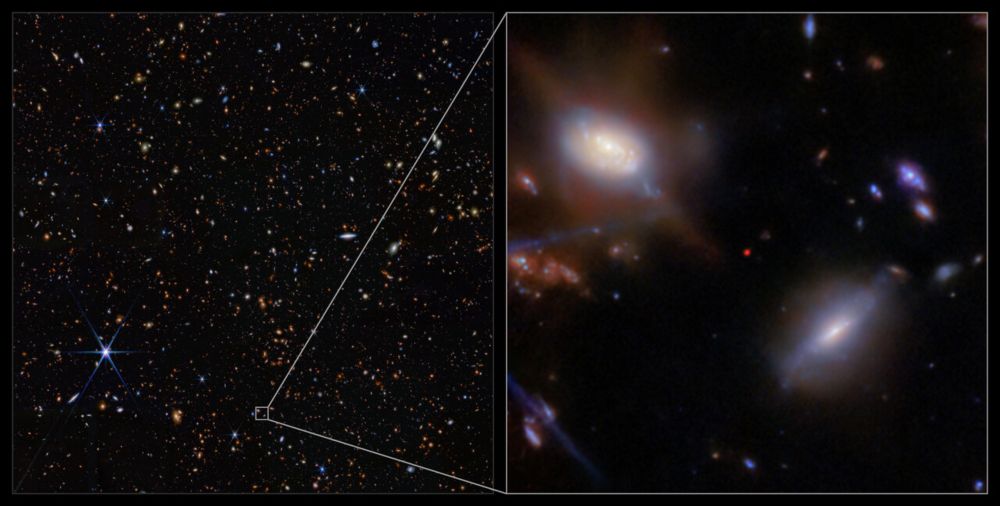
Unexpected, bright hydrogen emission caught astronomers by surprise
While the Universe right after the Big Bang was blisteringly hot, a rapid expansion and cooldown subsequently rendered it opaque to energetic ultraviolet light. This ‘fogginess’ was gradually cleared ...
Unexpected, bright hydrogen emission caught astronomers by surprise 🔭😳
I'm proud to have led a study reporting this surprising result, which is now published in @nature.com. Read more in this Behind the paper post and in the thread below! 👇
27.03.2025 15:41 — 👍 8 🔁 2 💬 1 📌 0

Oxygen discovered in most distant known galaxy
Two different teams of astronomers have detected oxygen in the most distant known galaxy, JADES-GS-z14-0. The discovery, reported in two separate studies, was made possible thanks to the Atacama…
📣 Using ALMA 📡, in which ESO is a partner, astronomers have discovered oxygen in the most distant known galaxy!
This record-breaking detection is making scientists rethink how quickly galaxies formed in the early Universe 🤔
Read more: www.eso.org/public/news/...
🔭 🧪 ☄️
20.03.2025 13:07 — 👍 43 🔁 13 💬 1 📌 1
Proud to have been part of Katherine's first PhD paper 👏👏 Her detailed study of a distant galaxy reveals what is likely an ongoing merger in a complex system containing both young and old stellar populations with new evidence for the presence of small carbonaceous grains – read more below!
03.03.2025 11:51 — 👍 8 🔁 2 💬 0 📌 0
How do we learn about the anatomy of the most distant galaxy we currently know of? 🩻
Read more below! 👇
11.02.2025 12:40 — 👍 1 🔁 0 💬 0 📌 0
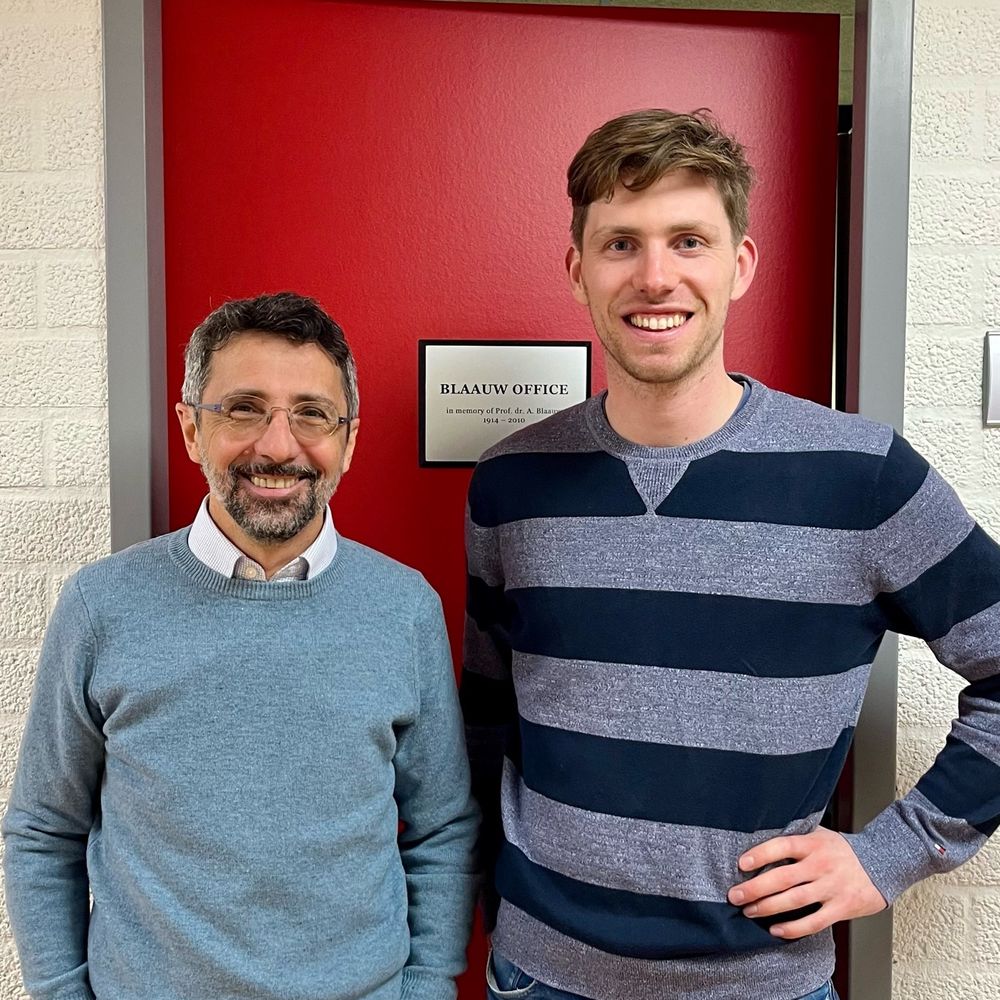
Had a wonderful time visiting the Kapteyn Astronomical Institute in Groningen last week. Congratulations to Roberto for being this year’s Blaauw professor and thanks to everyone at Kapteyn for your hospitality!
22.11.2024 11:06 — 👍 7 🔁 0 💬 0 📌 0
Don't fancy an Eerlijk Eten maaltijdbox?
21.12.2023 10:30 — 👍 1 🔁 0 💬 0 📌 0
Reminder about next year's conference on obscured star formation at the Kavli Institute for Cosmology, Cambridge (22-26 April), organised by Jan Scholtz and me. Abstract submission closes soon! sites.google.com/cam.ac.uk/sf...
27.11.2023 11:02 — 👍 1 🔁 0 💬 0 📌 0

Looking forward to learning more about the origin and fate of cosmic dust this week in Gothenburg ✨ #CosmicDustSweden2023
25.09.2023 08:51 — 👍 2 🔁 0 💬 0 📌 0
This seemed like a good first opportunity to dive into Blue Sky – thanks @emily.space for setting me up and @ojhall.bsky.social for providing the invite code!
07.09.2023 17:55 — 👍 4 🔁 0 💬 0 📌 0
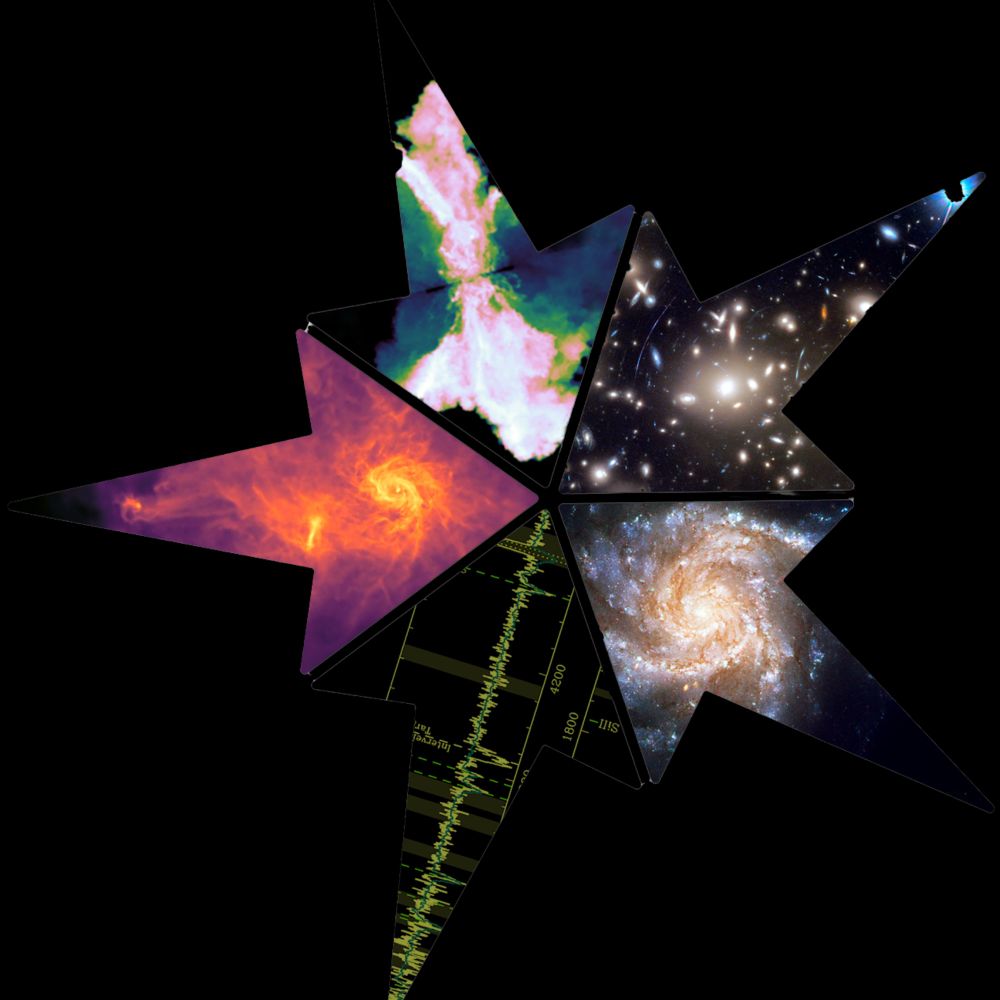
Star Formation 2024
A hybrid (online & on-site) meeting focusing on hidden and elusive star formation, from the local Universe to high redshift, and an occasion to remember Richard Hills
Jan Scholtz, myself et al. are excited to announce an upcoming conference at the Kavli Institute for Cosmology. "Raising the veil on star formation near and far" is a meeting dedicated to Richard Hills, remembering his contributions to understanding obscured star formation across cosmic time:
07.09.2023 17:53 — 👍 5 🔁 0 💬 1 📌 0
Extragalactic astrophysicist. Assistant Prof @ IST Austria - PI of ERC StG-2022 AGENTS. PhD Leiden 2018, Zwicky fellow @ ETH Zurich,2018-2023.
Freelance journalist. Science writer.
astrophysicist at university of oxford | very distant galaxies and supermassive black holes with JWST | the skies definitely seem bluer down here!
Keeping you posted on space science activities from the European Space Agency.
Web: http://www.esa.int/science
Privacy Notice: esa.int/connectwithus
#astronomy #space #science
#50YearsOfESA: we're the European Space Agency, keeping you posted on European space activities.
Please see our Privacy Notice: https://esa.int/connectwithus
Tasmanian astrophysicist studying black holes in the early Universe. Currently an Oppenheimer Fellow in Los Alamos, New Mexico ✨
The Cosmic Dawn Center (DAWN) DAWN is a collaboration between the Niels Bohr Institute (U. Cph) and DTU Space, dedicated to uncovering how the first galaxies, stars and black holes formed and evolved in the early Universe.
PhD Computational Physics. 🚀 Working on the nuclear fusion dream ⚛️
The European Southern Observatory designs, builds & operates world-class observatories on the ground for the benefit of society. More info on eso.org
Reader in observational astrophysics. Parent. From Amsterdam, living in Liverpool <3
Astronomer and associate professor at the University of Western Australia.
Copenhagen 🤍
Stud.cand.scient in astrophysics 🪐
Studying primordial galaxies and black holes at cosmic dawn
Assistant Professor at the Niels Bohr Institute / University of Copenhagen. Studies the formation of primordial galaxies and the chemical enrichment of the Universe
Astronomer @ MIT. First graduating class of Yale-NUS College, Singapore. 🇮🇳 →🇸🇬 →🇺🇸 https://rohannaidu.github.io/
Astrophysicist. Loves being lost and how alive it feels. Enjoys witnessing courageous authenticity and random acts of kindness.
Astro PhD at University of Cambridge 🌌 | 21cm cosmologist and high-redshift galaxy enthusiast | avid chai drinker ☕️ | occasional Wikipedia editor 🧩 | he/him
Check out my website: jitendhandha.com
 05.09.2025 19:20 — 👍 1 🔁 1 💬 0 📌 0
05.09.2025 19:20 — 👍 1 🔁 1 💬 0 📌 0

